Bluegill
Lepomis macrochirus
AKA: Bream, sunfish, sunnies, brim, sunperch
The bluegill is a popular game fish with many fishermen. They are found throughout the continental United States in various lakes, streams and ponds. Bluegills are quite easy to catch and make a great first catch for beginning anglers.
Distinguishing Markings:
Bluegills have small mouths and an oval shaped body deep and highly compressed. The fish is olive green on the upper body and light yellow on its belly with blue and purple iridescence on its cheeks and dark bands running up and down from the back fading into the belly. A dark blue or black "ear" appears on an extension of the gill cover, and a prominent dark blotch may show at the base of the dorsal fin, close to the tail. Breeding males may have more blue and orange coloration on their flanks
Size:
Typically about six inches, but can reach 12 inches. In some areas, they may approach five pounds in weight.
Distribution:
Bluegills appear to have been native to the eastern half of the United States, southeastern Canada and northeastern Mexico, exclusive of the coastal plain north of Virginia. Today, however, bluegills range inshore from the Great Lakes to Florida. Many times these fish will be stocked along with largemouth bass in ponds and lakes.
Habitat:
Bluegills are a freshwater fish, although they will venture into slightly salty water. They like quiet waters such as lakes, ponds and slow flowing rivers and streams and prefer to stay within calm pools within their residential bodies of water. This provides a sheltered area for them and protection from predators.
Food Preference:
They will eagerly eat spiders, insects, crayfish, fish eggs, and other small fish, while young bluegill often become food for larger fish, birds and water snakes.
Spawning:
Spawning takes place from April to September in fresh water. The male picks a good spot and makes a nest. After the female lays her eggs, the male guards the eggs and newly hatched young. Bluegills like to build their nests around other bluegill nests. Sometimes there are so many nests that the nest beds touch and look like honeycombs.
Fishing Tips:
Easily caught, bluegills are often the first fish that a young angler catches. They will hit most small baits, rising eagerly to earthworms, dough balls, or even corn kernels.
If you’re new to freshwater fishing, or a seasoned angler looking for a new fishing boat, see our page on the best boats for freshwater fishing.

